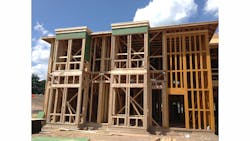Within the broad discipline of structural fire suppression and firefighting, the factor that defines all phases of operations, tactical assignments, command and incident outcomes is building structure and occupancy. Today’s buildings and their occupancies present increasing challenges that are redefining strategic and tactical fireground operations and changing the rules of engagement in structural fires.
Unlike the past decade or even the preceding 1990s, today’s evolving fireground demands greater adaptive insights and management That means an amplified understanding of buildings, building anatomy and occupancy risk profiling by all companies operating on the fireground. This requires knowledge of building construction, architecture, engineering, fire dynamics and fire suppression methodologies. The equation for success rests directly on “Building Knowledge = Firefighter Safety.”
The building itself is not the enemy; the fire within its compartment and perimeter walls is. With the increasing attention toward fire behavior, fire dynamics and fire suppression practices based on emerging research, cursory or obligatory dialogue related to the building makes its way into the discussions, but not to the same level of perspective or vigor. Before we can effectively discuss flow-path theory and applications and the implication and application to firefighting operations, we must understand the compartment within the context of the building; its envelope and the complexities of the building anatomy.
Impact of new research and construction types
Not since the late 1980s and early 1990s has the fire service seen such a robust and passionate discussion and dialogue related to interior firefighting theory, practices and methodologies. The past 18 months have seen elevated emerging research, subsequent findings and data points that identify and postulate a wide range of suggested advances, conclusions and deductions. Fire service scientists and practitioners are connecting the dots with empirical data that challenges many imbedded anecdotal practices and long-held beliefs.
We used to discern with a measured degree of predictability how buildings would perform, react and fail under most fire conditions. Implementing fundamentals of firefighting and engine company operations built upon nine decades of time-tested and experience-proven strategies and tactics continues to be the model of suppression operations. These same fundamental strategies continue to drive methodologies and curriculums in our current training programs and fire academy instruction.
Our buildings have changed – this means the structural systems of support, the degree of compartmentation, the characteristics of materials and the magnitude of fire loading. The structural anatomy, predictability of building performance under fire conditions, structural integrity amid extreme fire behavior and accelerated fire growth and intensity typically encountered in buildings of modern construction during initial and sustained fire suppression operations have given new meaning to the term “combat fire engagement.”
The fundamental compartment that comprised a typical room configuration in terms of area (square footage), volume (height and width), furnishings (fire load package) and construction materials (structural anatomy) found within conventional, legacy or heritage construction provided predictability in terms of fire suppression, fire behavior, operational time and survivability (civilian/firefighter). But there have been dramatic changes since the early 1980s in the evolution of modern building construction and the institutionalization of engineered structural systems (ESS).
If you don’t know and understand the buildings in your response area, how can you identify and select appropriate firefighting strategies and tactics? How can you devise a suitable incident action plan unless you factor in changes in fire loads, the introduction of new building materials and technologies and risks to occupants? If you are going to command or tactically engage at a structure fire, you had better understand the building, for there is a diminishing and limited margin for error on today’s evolving fireground. Errors and omissions are unforgiving and may not be recoverable, leading directly to adverse conditions, possibly even including serious firefighter injuries and line-of-duty deaths.
It is no longer just brute force and sheer physical determination that define structural fire suppression operations, although any seasoned command and company officer knows that, at times, those are what gets the job done under the most arduous and demanding circumstances. However, from a methodical and disciplined perspective, aggressive firefighting operations must be aligned to the building’s inherent predictability of performance and occupancy risks. That means devising goal-oriented tactical operations that are defined by assessed risks and analyzed tasks that are executed under battle plans that promote the best in safety practices and survivability within know hostile structural fire environments while maintaining the values and tradition that define the fire service.
Christopher J. Naum presents “Reading Buildings” and “Buildings on Fire: Lessons from the Fireground” at Firehouse World 2014.
CHRISTOPHER J. NAUM, SFPE, a Firehouse® contributing editor, is a 39-year fire service veteran and national instructor, author and lecturer. He is an authority on building construction issues affecting the fire and emergency services and a former fire command officer, architect and fire protection engineer. Naum is a technical consultant to the NIOSH Firefighter Fatality Investigation and Prevention Program, a NFFF Firefighter Safety Advocate and served on the Board of Directors of the ISFSI and the IAFC Safety, Health & Survival section and faculty at the National Fire Academy. He is the executive producer of Buildingsonfire.com, a site dedicated to building construction, adaptive fire command and firefighter safety.
Connect with Chris
Email: [email protected] & Buildingsonfire.com
Facebook: Buildingsonfire
Photo caption:
The complexities of today’s wood-frame buildings constructed with engineered structural components, systems and assemblies continues incorporating engineering principles that create buildings and occupancies that when exposed to developing fire conditions have far-reaching repercussions affecting building resiliency and integrity and firefighter safety. Photo courtesy of the author






